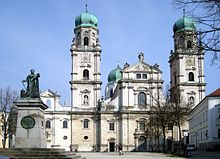Prince-Bishopric of Passau
|
Diocese of Passau Dioecesis Passaviensis Bistum Passau |
|
|---|---|

St. Stephan's Cathedral, Passau
|
|
| Location | |
| Country | Germany |
| Ecclesiastical province | Munich and Freising |
| Metropolitan | Munich and Freising |
| Statistics | |
| Area | 5,442 km2 (2,101 sq mi) |
| Population - Total - Catholics |
(as of 2004) 591,205 515,852 (87.3%) |
| Information | |
| Denomination | Roman Catholic |
| Sui iuris church | Latin Church |
| Rite | Roman Rite |
| Established | 737 |
| Cathedral | St. Stephan's Cathedral |
| Patron saint |
St. Conrad of Parzham St. Maximilian of Celeia St. Valentine |
| Current leadership | |
| Pope | Francis |
| Bishop | Stefan Oster |
| Metropolitan Archbishop | Reinhard Marx |
| Emeritus Bishops | Wilhelm Schraml |
| Map | |
 |
|
| Website | |
| bistum-passau.de | |
| Prince-Bishopric of Passau | ||||||||||
| Fürstbistum Passau | ||||||||||
| State of the Holy Roman Empire | ||||||||||
|
||||||||||
| Capital | Passau | |||||||||
| Government | Principality | |||||||||
| Historical era | Early modern period | |||||||||
| • | Bishopric established | 722 | ||||||||
| • | Gained Reichsfreiheit from Otto III |
999 | ||||||||
| • |
Bernhardine Charter grants burghers municipal freedoms |
1299 |
||||||||
| • |
Peace of Passau during Reformation |
1552 |
||||||||
| • | Secularised to Bavaria | 1805 | ||||||||
|
||||||||||
The Diocese of Passau is a Roman Catholic diocese in Germany that is a suffragan of the Archdiocese of Munich and Freising. It should not be confused with the Prince-Bishopric of Passau, an ecclesiastical principality that existed for centuries until it was secularized in 1803. The diocese covers an area of 5,442 km².
Pope Benedict XVI was born and baptized on Holy Saturday, 16 April 1927, at Marktl am Inn, which is located within the Diocese of Passau.
The Diocese of Passau may be considered the successor of the ancient Diocese of Lorch (Laureacum). At Lorch, a Roman station and an important stronghold at the junction of the Enns River and the Danube, Christianity found a foothold in the third century, during a period of Roman domination, and a Bishop of Lorch certainly existed in the fourth. During the great migrations, Christianity on the Danube was completely rooted out, and the Celtic and Roman population was annihilated or enslaved.
In the region between the Lech River and the Enns, the wandering Bajuvari were converted to Christianity in the seventh century, while the Avari, to the east, remained pagan. The ecclesiastical organization of Bavaria was brought about by St. Boniface, who, with the support of Duke Odilo or at least enacting an earlier design of the duke, erected the four sees of Freising, Ratisbon, Passau, and Salzburg. He confirmed as incumbent of Passau, Bishop Vivilo, or Vivolus, who had been ordained by Pope Gregory III, and who was for a long time the only bishop in Bavaria. Thenceforth, Vivilo resided permanently at Passau, on the site of the old Roman colony of Batavis. Here was a church, the founder of which is not known, dedicated to St. Stephen. To Bishop Vivilo's diocese was annexed the ancient Lorch, which meanwhile had become a small and unimportant place. By the duke's generosity, a cathedral was soon erected near the Church of St. Stephen, and here the bishop lived in common with his clergy.
...
Wikipedia

